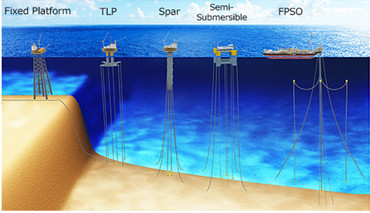The Drill Down, Issue #6: OCS Production Facility Regulatory Compliance Standards
 Introduction
Introduction
After successfully drilling an offshore well that bears hydrocarbons, a means to extract and process the discovered energy resources is needed. OCS production facilities serve this purpose, producing and separating oil and gas prior to transporting to shore. In this issue, we will explore the regulatory compliance standards for the various categories of OCS production facilities. In Drill Down Issue No. 5, the different production facility designs were explored in greater detail. As a brief review, the image below (Source: MODEC) depicts the spectrum of production facilities on the U.S. OCS.

Authority
Coast Guard authority on the OCS is derived from the Outer Continental Shelf Lands Act (OCSLA), 43 U.S. Code, Subchapter III (§1331 et seq.), with OCS activities regulated under OCSLA and 33 CFR Subchapter N (Parts 140-147).
Compliance Standards
From a Coast Guard regulatory perspective, there are three basic categories for OCS production facilities:
- Fixed OCS Facilities (Fixed Platforms)
- Floating OCS Facilities (Commonly termed Floating Offshore Installations (FOIs), such as Tension Leg Platforms (TLPs), Spars, Semi-Submersibles)
- Shipshape Floating OCS Facilities (FPSOs, FPSs)
All OCS Facilities – on the U.S. OCS are regulated under 33 CFR Subchapter N.
Fixed OCS Facilities – requirements are entirely contained within 33 CFR Subchapter N.
Floating OCS Facilities – requirements are contained in 33 CFR Subchapter N as well as 46 CFR Subchapters I-A (107, Subpart C & 108), F (50 to 64) and J (110 to 113) as per 33 CFR 143.120.
Shipshape Floating OCS Facilities – Currently all facilities in this category are foreign-flagged. The requirements contained within 33 CFR Subchapter N still apply. Even though operating as production facilities, these are also considered vessels, and are typically required to comply with the SOLAS rules. Additionally, there may be Flag State and Classification Society requirements that apply.
Note – Floating OCS Facilities have the option to be designed, built and inspected to a Design Basis Agreement (DBA). CG-ENG Policy Letter 01-13 details the provisions associated with this alternative. See the flow chart of the regulatory compliance options for OCS production facilities.
Coast Guard Documents Issued:
Fixed OCS Facilities – A letter is issued acknowledging completion of the initial inspection and listing the start date of annual self-inspections. Subsequent self-inspections are documented on a Form CG-5432 by the owner/operator, which are retained for 2-years.
Floating OCS Facilities – While FOIs are substantially moored to the seafloor and are not “Documented” vessels, they are issued a Certificate of Inspection (COI) every 5 years and require annual inspections.
Shipshape Floating OCS Facilities – Since these are all currently foreign-flagged, a Certificate of Compliance (COC) is issued every 2 years and require annual examinations.
Conclusion
This provides a broad overview of the regulatory compliance scheme for current Facilities on the U.S. OCS. The Marine Safety Manual (MSM) Vol. II, Section G, Chapters 4 & 5 provide additional details and guidance.